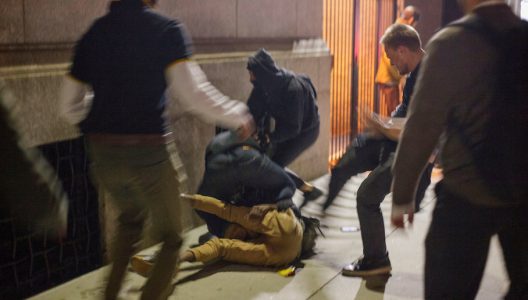
New York City law enforcement officers acknowledged in court last week that they use information provided by antifa members to bust Proud Boys.
Testifying against two men connected to the Proud Boys, a group of right-wing ruffians, the officials said that their investigation relied on doxxing by activists from antifa, a far-left group.
“There was a tremendous amount of what we call ‘doxxing,’” NYPD Detective Thomas Mays told jurors, referring to the vindictive disclosure of personal information online. “Names that were given for the individuals.”
The trial, in State Supreme Court in Manhattan, concerns a clash outside an Oct. 11 appearance by Proud Boys Founder Gavin McInnes. Following the event at the Upper East Side’s Metropolitan Republican Club, 1o of McInnes’ followers surrounded and beat four black-clad protestors who confronted them.
According to The New York Times, the victims have refused to cooperate with the investigation, and police believe they are antifa members. Investigators have failed to identify the men despite what they described as a concerted effort: appealing to the FBI, checking phone records and hiring a private facial recognition company to analyze images.
As a result, the four victims have been referred to only as Shaved Head, Ponytail, Khaki and Spiky Belt. Their whereabout are unknown.
By contrast, police were able to identify all the Proud Boys associates involved in the incident, which was documented by multiple videos. They said they were aided by a list of ticket holders to the McInnes event, which was handed over by the Republican Club.
Smoking and kicking
According to prosecutors, Hare, a 26-year-old Amtrak employee, started the fight by charging at the protestors, and Kinsman, 39, delivered a series of kicks while holding an iron fence for leverage; he continued smoking his cigarette throughout.
An expert on antifa and the Proud Boys, Oren Segal of the Anti-Defamation League, testified for the prosecution about the rivalry between antifa and the Proud Boys. He described both groups as extremists who relish fighting online and in the streets.
Meanwhile, defense lawyers have argued that their clients were acting in self defense. They presented testimony about masked figures attacking the Republican club on the eve of McInnes’ talk, throwing bricks through the windows, spray painting anarchist symbols on the front door and leaving behind a threatening communiqué that warned “our attack is merely a beginning.”
Kinsman’s lawyer, Jack Goldberg, has questioned how the authorities were able to locate the Proud Boys but not the antifa members.
More than antifa versus the Proud Boys
Beyond the courtroom, political left and right have lately sparred over how law enforcement handles violent extremism. Liberals have argued that white supremacy is resurgent under President Donald Trump and accused the FBI of not taking it seriously because of institutional racism. Since the Aug. 3 mass shooting in El Paso, Texas, which appears to have targeted immigrants, Rep. Alexandria Ocasio-Cortez, a New York Democrat, has led calls for a revival of domestic terrorism laws to crack down on the far right.
For their part, some conservatives have dismissed such fears as overblown. They have complained that law enforcement is often too lenient antifa protestors and that the media and politicians dismiss their warnings about far-left violence, including a mass shooting in Dayton, Ohio, just hours after the El Paso massacre.
Last week, a left-wing media network leaked an FBI report that showed the agency sees “black identity extremists” as a bigger threat than white supremacists.
*story by the Pluralist